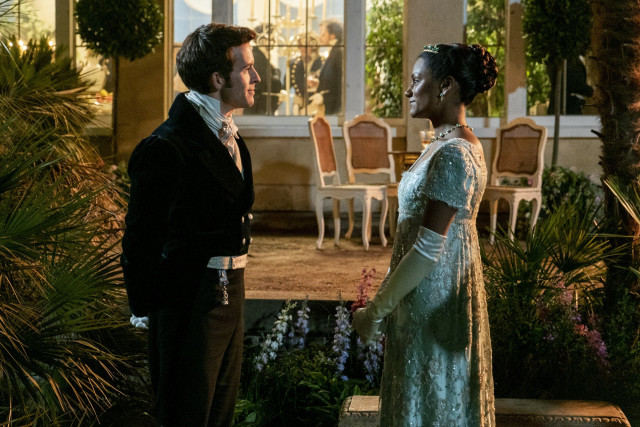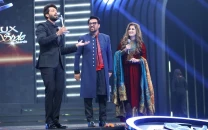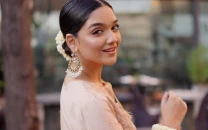Netflix hit series 'Bridgerton' and the art of non-traditional casting
The first season broke records. Season 2 features once again a diverse cast. But there's more to the series' success.

Netflix saw a lucrative first season with the period drama Bridgerton by US producer Shonda Rhimes. Now audiences are eager for the next season, to be released on the streaming service on March 25.
It's once again about love, intrigue and intimacy — only this time it's not a young white woman looking for a good match, but her older brother, Lord Anthony. The series is set in the 1810s British royal court. Some of the main characters are People of Color, including the British queen and Viscount Bridgerton's love interest.
Casting actors who have a different skin colour from the literary characters they play, or even having them portray historical figures they do not resemble because of their racial or ethnic background, is called colour-blind casting and has been common practice in British theatre for years.
Increasingly, colour-blind casting is also being used in English-language film and television — which often leads to controversy.
Promotional images of the characters from Amazon Prime's new series based on The Lord of the Rings led some social users to complain about the fact that the series features women with swords and people with brown and black skin. Colour-blind casting and equal gender roles are "not authentic," they say.
'Conscious decision to reinterpret history'
Actors Equity in the US prefers to call it "non-traditional" casting, according to Ellen Harrington, the director of the Frankfurt-based German Film Institute and Film Museum.
In the past, film sets were cast with white people, right down to the crew members and the smallest roles, Harrington told DW. That's not true for Bridgerton, she says, adding that casting People of Colour as members of the royal court was a conscious decision to reinterpret and retell history.
Bridgerton is based on the eight-volume series of novels by Julia Quinn about the fictional Bridgerton family. Unlike in the series, Queen Charlotte does not appear in the novel.
By casting Golda Rosheuvel as the Queen, series creators Shonda Rhimes and Chris van Dusen returned to a historical debate that Sophie Charlotte zu Mecklenburg-Strelitz, born in 1744, is said to have had African ancestors — which means she could indeed have been the first Black British queen.
Diversity on German TV
German film and TV producers could take an example from this kind of "non-traditional" casting, Nigerian-German actor Sheri Hagen told DW.
Black people or LGBTQ people appear more often in German series these days, but sometimes, their characters simply perpetuate stereotypes.
Diversity is not about having the token Black actor in a TV series, but rather a holistic approach, says Hagen. It's not just important who's in front of the camera, but who writes the script, how these stories are communicated and who implements the ideas in front of the camera, she adds.
In Germany, unlike the UK and the US, there is little public debate about the various dimensions of diversity that issues like inclusion in society and — by implication — the portrayal of minorities on TV and in entertainment in general should entail.
Sexual minorities more visible
"Homosexuals, transsexuals and other groups are definitely represented on German television. Germany is much more liberal than other countries," Dean Baykan, an actor who was born in Germany to Turkish parents, told DW in 2021.
Compared to Germany, other European countries — including Hungary, where the public display of lifestyles that do not conform to so-called traditional family values is forbidden by law — are very strict in their rejection of homosexuality.
"While Germany pretends to be open in many ways, it is also conservative at times," according to Baykan, who adds that foreigners or people with foreign roots are not taken seriously in feature films or acting projects.
Diversity pays off
At the very least since the 2016 #OscarsSoWhite debates, Hollywood has made efforts to bring more diversity into the film industry and to let People of Color tell stories from their perspectives.
One reason: such films do well at the box offices. "In Hollywood there's a direct correlation between higher profits and a diverse cast or a film that shows a more diverse world," says the German Film Institue's Harrington.
In the case of Bridgerton, too, it's hard to deny this connection.
It was the biggest-ever debut for an original series on Netflix, wrote Jinny Howe, Netflix vice president of drama development, in a blog in January 2021 shortly after the release of the first season. Some 82 million households worldwide watched the series within the first month.
Netflix is already planning seasons 3 and 4, as well as a miniseries about Charlotte as a young queen, based on a screenplay by Shonda Rhimes.
No historical novel
However, the success of the series can't be attributed solely to the diversity of the cast. "Romance books have always sold incredibly well," wrote Howe ahead of the release via Deadline.
Bridgerton is above all a romance, not a historical novel or even a realistic documentary but a dramatic, funny and lustful play about the love lives of wealthy, handsome people.
None of the above is new in the tradition of storytelling: the medieval king Arthur sagas are "romances," too, tales of romantic adventure that emerged long before the novel or modern historiography. Fairy tales where brave knights fight dragons, powerful women cast spells over entire kingdoms, and young nobles fall in love with the castle lord's wife also refer to this ancient tradition.
Even back in the Middle Ages, the stories were not about being historically accurate or realistic.
Bridgerton doesn't set out to be realistic either, says Howe, but rather fun. The goal, she said, is to create a world that "people of all backgrounds and ages can wonderfully escape into."



















COMMENTS
Comments are moderated and generally will be posted if they are on-topic and not abusive.
For more information, please see our Comments FAQ